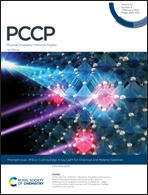Understanding the singlet–triplet energy splittings in transition metal-capped carbon chains†
Abstract
The singlet–triplet energy splittings (STES) of dication carbon chains capped by three 16-electron and two 14-electron configuration transition metal termini have been investigated using density functional theory. All five transition metal-capped carbon chains (MCC) exhibit an odd–even STES alternation, suggesting that it is a general feature of the MCCs. Analysis of the frontier molecular orbitals indicates that the frontier and neighboring molecular orbitals (MOs) are π orbitals delocalized over the entire carbon chain, the transition metal termini, and the ancillary ligands. In even and odd metal–carbon chains the HOMOs and LUMOs are nearly degenerate and non-degenerate, respectively, resulting in the even–odd STES alternation. Further analysis of the MOs in the MCCs and the uncapped carbon chains indicate that the STES of the MCCs are determined substantially by the uncapped carbon chain. Other ancillary ligands also play important roles in tuning the energy splitting through their π donor and acceptor abilities. These observations are helpful for the design of cumulene materials exhibiting tunable electronic and optical properties.



 Please wait while we load your content...
Please wait while we load your content...